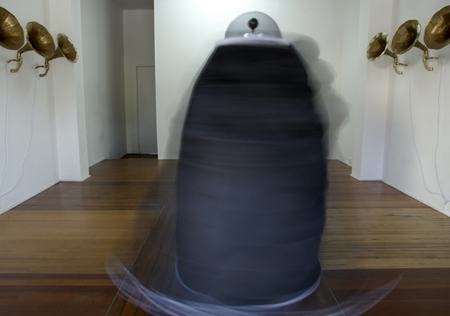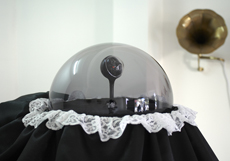the discreet charm of the bourgeoisie robot
 |
Wade Marynowsky |
conversational deviationsIt's worth going in to see The Discreet Charm of the Bourgeoisie Robot completely unprejudiced, but better yet to bring someone else uninformed along. The scene is this: both side walls of the gallery are lined with gramophone horns that hiss gentle static; a robot spins around the floorboards at the arrival of each new guest. Human height, its mechanism is hidden by a lace-trimmed black bustle; a single (also lace-trimmed) video camera eye beneath a plastic dome is all that ties this machine to the 21st century. At a glance it resembles the autonomous robotics experiments of Mari Velonaki's Fish-Bird, minus the Research Council support: the machine's erratic trajectory and myopic focus speaks of the buggy algorithms of artificial intelligence on an arts grant budget, and the tinny, canned voice sounds the routine synthesised knell of another 'new' media interactive. But the apparent autonomy is a ruse. The "programmed" conversation progresses from "How are you, sir?" to discussion of its dance moves, the gallery's interior design, to suspiciously well-informed digs about your personality. At least, they're well-informed if you are personally known to the wizard behind the curtain, a role played during my visit by Wade Marynowsky himself. Marynowsky has taken pains to situate his show at the juncture of several respectable cybernetics and performance theories and sophisticated technical design. For all this attention to the machine, though, the real exhibit is the interplay with gallery-goers who wander in unawares from the leafy Newtown back-street. My unbriefed friend, a counsellor from out of town, questions the bourgeoisie robot as she would any other client. Immediately, their conversation invokes and inverts that old new-media parody, the ELIZA psychoanalysis program. Buying into the performance with an analyst's unabashed comfort with the personal, she leaves the robot scrabbling for consistency as she dissects its absurd motivations and fashion sense. And, eventually, dresses it in her scarf. The robot bursts out of its conversation, trundles towards me crying plaintively, "You sir, with the hat! Tell me, are you enjoying the show?" Marynowsky's willingness to be no less ludicrous than us, his supposed patsies, is what charms me. And it's what seduces me into further collusion. Rumour has it that the next iteration of the project will see multiple such robots unleashed on the public. If it is still intimate enough a scene for complicity in absurdity, I recommend you attend. And bring a friend. Dan Mackinlay |
 |
Wade MarynowskyBy appropriating the title of the film The Discreet Charm Of The Bourgeoisie (1972) I pay homage to the surrealist film director Luis Buñuel. The film is about a group of upper middle class people attempting, despite continual interruptions, to dine together. So what is Buñuel trying to say? That the bourgeoisie are charming because they have nothing to worry about except how and when they will dine together? Or that they are in fact hideous creatures with nothing better to do than waffle about? |








 back
back